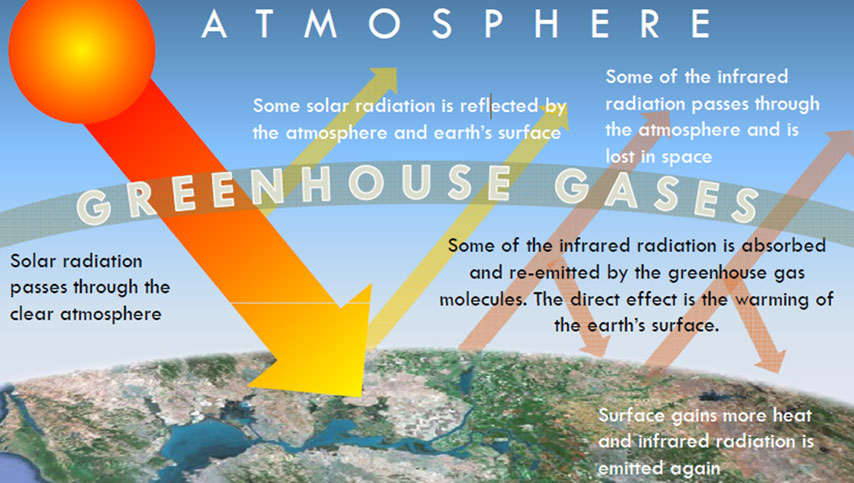Climate vs Weather
- Weather is the temperature, humidity, precipitation, cloudiness and wind that we experience in the atmosphere at a given time in a specific location.
- Climate is the average weather in a region over a long time period (30 – 50 years).
- Climate change is a systematic change in the long-term state of the atmosphere over multiple decades or longer.
What causes climate change?
- At its most basic, climate change is caused by a change in the earth’s energy balance — how much of the energy from the sun that enters the earth (and its atmosphere) is released back into space.
- The earth is gaining energy as we reduce the amount of solar energy that is reflected out to space.
- Since the Industrial Revolution started over 200 years ago, human activities have added very large quantities of greenhouse gases into Earth’s atmosphere.
- These gases act like a greenhouse which traps the sun’s energy and heat, rather than letting it reflect back into space.
- When the concentration of these gases is too high, too much heat is trapped, and the earth’s temperature rises outside the range of natural variability.
- There are many greenhouse gases, each with a different ability to trap heat and a different half-life in the atmosphere.
Greenhouse Gases
- Carbon dioxide (CO2) is the greenhouse gas responsible for greatest amount of warming to date.
- The majority of CO2 is released from the incomplete combustion of fossil fuels – coal, oil, and gas – used for electricity production, transportation and industrial processes.
- Together, these three activities account for more than 80% of the CO2 released into the atmosphere.
- Other important greenhouse gases include methane, nitrous oxide, black carbon, and various fluorinated gases.
- Although these gases are emitted in smaller quantities than CO2, they trap more heat in the atmosphere than CO2 does.

Critical Changes caused by Climate Change
Warming temperature of the earth’s surface and the oceans:
- The earth has warmed at a rate of 0.13° C per decade since 1957, almost twice as fast as its rate of warming during the previous century.
Changes in the global water cycle:
- Over the past century there have been distinct geographical changes in total annual precipitation, with some areas experiencing severe and long-term drought and others experiencing increased annual precipitation.
- Frequency and intensity of storms increases as the atmosphere warms and is able to hold more water vapour.
Declining glaciers and snow pack:
- Across the globe, nearly all glaciers are decreasing in area, volume and mass.
- One billion people living in river watersheds fed by glaciers and snow melt are thus impacted.
Sea level rise:
- Warmer water expands, so as oceans warm the increased volume of water is causing sea level rise.
- Melting glaciers and snow pack also contribute to rising seas.
Ocean acidification:
- Oceans absorb about 25% of emitted CO2 from the atmosphere, leading to acidification of seawater.
Climate Change Effects
- Greater variability, with “wetter wets”, “drier dries” and “hotter hots”.
- More frequent and severe extreme heat events .
- More severe droughts .
- More intense precipitation, such as severe rains, winter storms and hurricanes.
- Higher average temperatures and longer frost-free seasons.
- Longer wildfire seasons and worse wildfires.
- Loss of snow pack and earlier spring runoff.
- Recurrent coastal flooding with high tides and storm surges.
- More frequent and severe floods due to intense precipitation and spring snowmelt.
- Worsening air quality: Higher temperatures increase production of ozone (a key contributor to smog) and pollen, as well as increasing the risk of wildfires.
- Longer pollen seasons and more pollen production.
Extracted from Climate Change 101: Climate Science Basics. Published by the Centre for Climate Change and Health, 2016.

